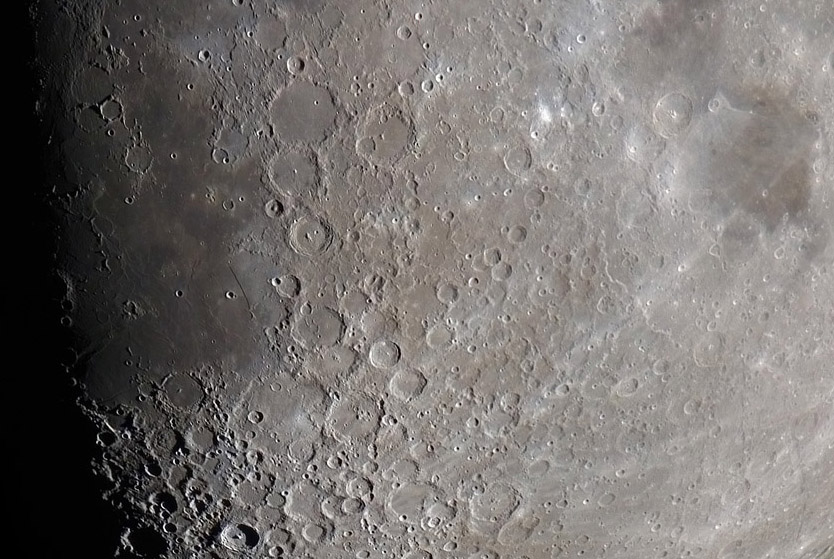|
|
| (5 intermediate revisions by the same user not shown) |
| Line 1: |
Line 1: |
| | __NOTOC__ | | __NOTOC__ |
| | =Partial Phase of Pinkness= | | =Partial Phase of Pinkness= |
| | + | <!-- Start of content --> |
| | <div class="post" id="post-751"> | | <div class="post" id="post-751"> |
| | | | |
| Line 6: |
Line 7: |
| | <p>[[File:Moon20061129-LPOD.jpg|moon20061129-LPOD.jpg]]<br /> | | <p>[[File:Moon20061129-LPOD.jpg|moon20061129-LPOD.jpg]]<br /> |
| | <em>image by [mailto:digidodi@telenet.be Dominique “Dodi” Dierick], Belgium</em></p> | | <em>image by [mailto:digidodi@telenet.be Dominique “Dodi” Dierick], Belgium</em></p> |
| − | <p>Color enhanced [http://www.lpod.org/archive/fr/ILUJ-2005-02-07.htm images] of the Moon show much variation in the hues of mare lavas, especially around Mare Serenitatis and within Mare Imbrium. But the highlands are less flamboyant in their subtle colorations. Dodi’s lovely mosaic - here in reduced area and resolution compared to the spectacular [http://www.astronomie.be/dodi/moon20061129.jpg original] - shows that the southern highlands are largely mixes of milkiness for Tycho’s rays and a washed and rusty pink. The variation in mare colors is due to the large differences in titanium abundances in lunar basslts - much more than is common in terrestrial ones. Highland rocks have very little titanium and iron - they sank toward the core when the magma ocean existed - so they are monotonous in their pinkiness (except for one or two small [http://www.lpod.org/?m=20060312 surprises]). There must be differences in the composition of different parts of the highlands but so far imaging has had little success in finding them.</p> | + | <p>Color enhanced [http://www.lpod.org/archive/fr/ILUJ-2005-02-07.htm images] of the Moon show much variation in the hues of mare lavas, especially around Mare Serenitatis and within Mare Imbrium. But the highlands are less flamboyant in their subtle colorations. Dodi’s lovely mosaic - here in reduced area and resolution compared to the spectacular [http://www.astronomie.be/dodi/moon20061129.jpg original] - shows that the southern highlands are largely mixes of milkiness for Tycho’s rays and a washed and rusty pink. The variation in mare colors is due to the large differences in titanium abundances in lunar basslts - much more than is common in terrestrial ones. Highland rocks have very little titanium and iron - they sank toward the core when the magma ocean existed - so they are monotonous in their pinkiness (except for one or two small [[March_12,_2006|surprises]]). There must be differences in the composition of different parts of the highlands but so far imaging has had little success in finding them.</p> |
| | <p>[mailto:tychocrater@yahoo.com Chuck Wood]</p> | | <p>[mailto:tychocrater@yahoo.com Chuck Wood]</p> |
| | <p><strong>Technical Details:</strong><br /> | | <p><strong>Technical Details:</strong><br /> |
| Line 12: |
Line 13: |
| | <p><strong>Related Links:</strong><br /> | | <p><strong>Related Links:</strong><br /> |
| | [http://www.astronomie.be/dodi/astro/astmenu.htm Dodi’s twilight zone of photography]</p> | | [http://www.astronomie.be/dodi/astro/astmenu.htm Dodi’s twilight zone of photography]</p> |
| − | <p><i>Christmas is coming - consider leaving a list of lunar books on top of a spouse’s pillow - just make sure you include the LPOD URL so that you support [http://www.lpod.org/?page_id=591 LPOD] when buying lunar books (or ANY book) from Amazon!</i></p> | + | <p><b>Yesterday's LPOD:</b> [[December 1, 2006|Half a Loaf]] </p> |
| | + | <p><b>Tomorrow's LPOD:</b> [[December 3, 2006|Seeking Secchi]] </p> |
| | + | <!-- Removed reference to store page 2 --> |
| | </div> | | </div> |
| − | ---- | + | <!-- End of content --> |
| − | ===COMMENTS?===
| + | {{wiki/ArticleFooter}} |
| − | Click on this icon [[image:PostIcon.jpg]] at the upper right to post a comment.
| |




